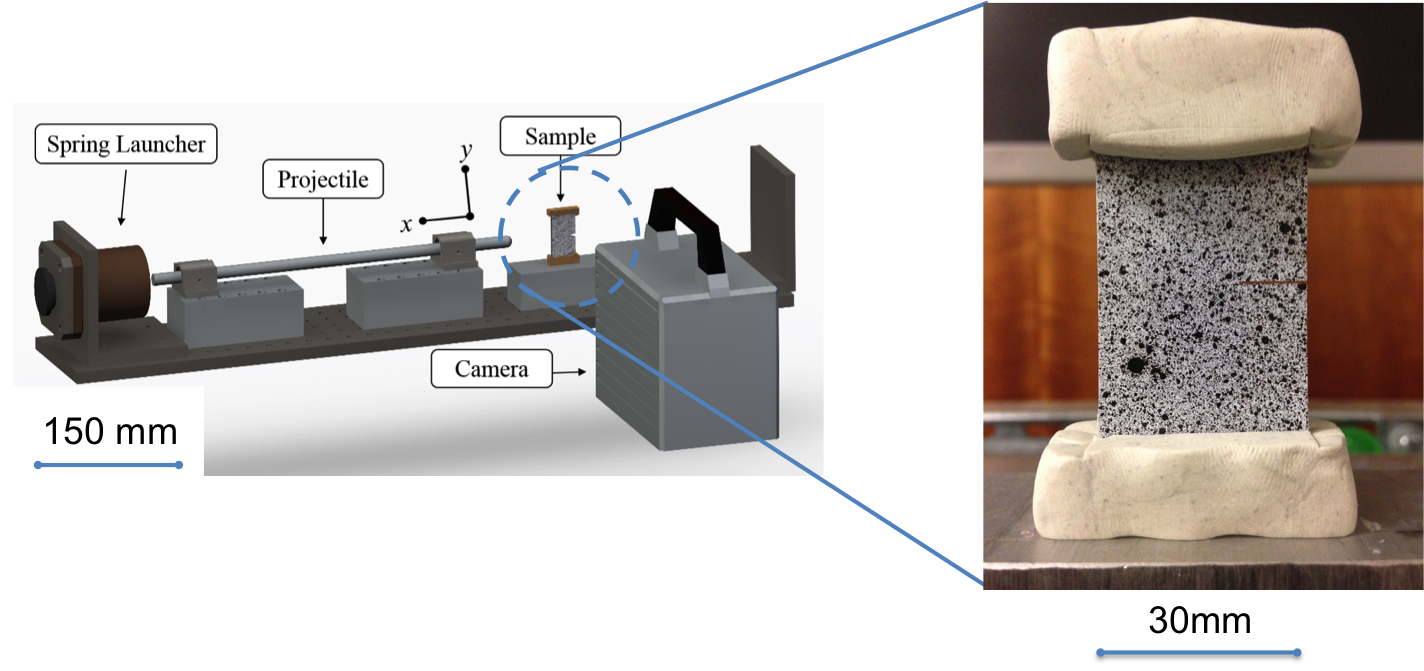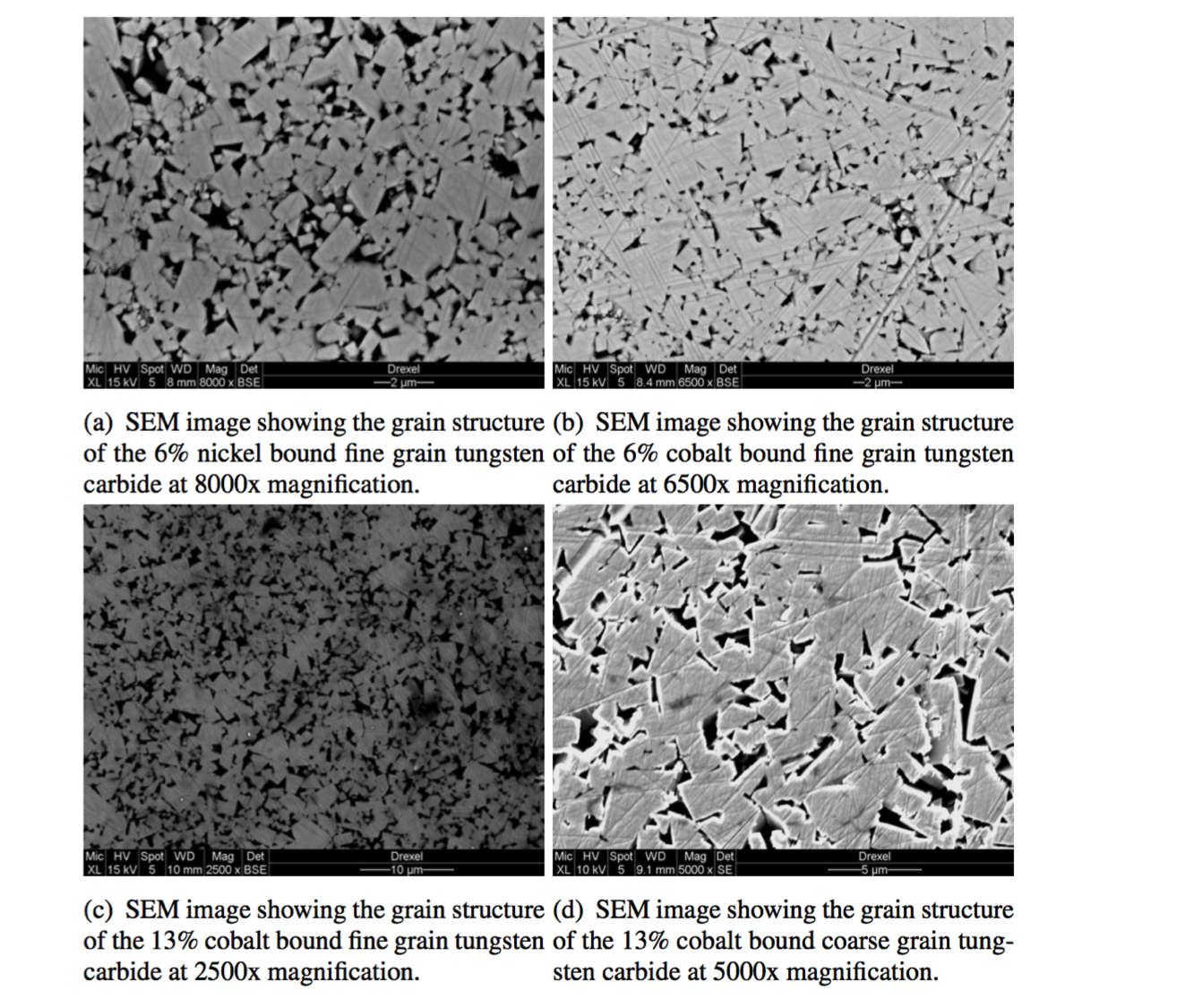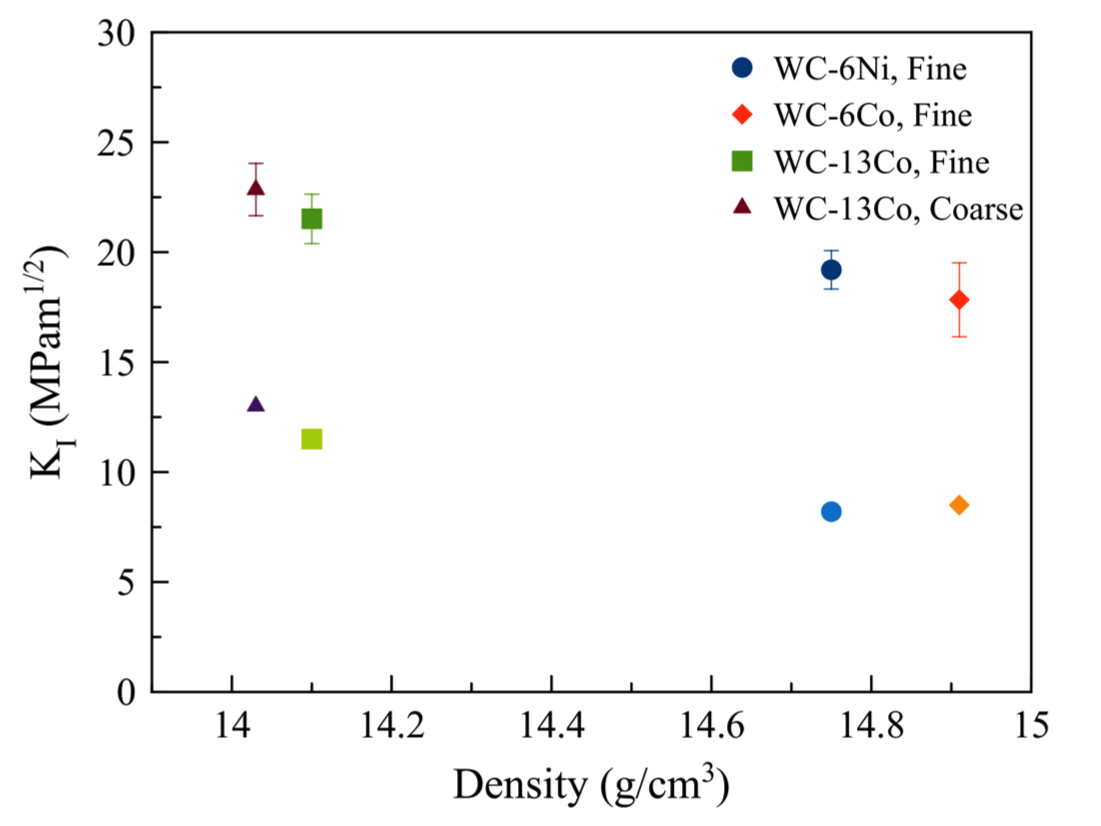Reports: ND1055860-ND10: Impact Fatigue Behavior of WC-Co Cemented Carbides: Microstructure and Stress Wave Interactions
Leslie Elise Lamberson, PhD, Drexel University
In the first year of support from the New Directions grant, the PI and associated graduate student were able to experimentally investigate four commercially available grades of cobalt and nickel cemented tungsten carbide (WC) of varying grain sizes and binder percentages under impact fracture conditions. These tests were used to characterize the Mode-I (crack opening) dynamic stress intensity factor at fracture initiation. The resulting crack tip energetics and initiation toughness under high rate loading is imperative in understanding hardmetal strength and wear resistance for use in drill bits for a few key reasons. First, (to the PIs knowledge) these values have never been explicitly characterized using the principles of dynamic fracture mechanics, nor has the relation between localized inertial toughening on the microstructural scale with the continuum level fracture behavior been systemically explored. Further, these empirical single-strike characterizations are needed to develop appropriate experimental schemes to investigate dynamic impact fatigue behavior, or multiple sub-catastrophic impacts until failure. Lastly, these findings can be directly used in computational models as a more accurate fracture criterion to predict failure under complex wave-driven loading conditions (which is of particular relevance in petroleum extraction and the development of percussive drilling techniques). Overall, we found that the dynamic fracture toughness values were higher on average than the quasi-static (non-wave-driven) fracture toughness values by a factor of 1.25 to 2. These findings suggest that the accumulated energy at crack formation is more sensitive to inertial-dependent toughening mechanisms than underlying grain size or binder content.
In addition, preliminary studies of WC-Co under repetitive impact fatigue conditions were successfully conducted. What is interesting to note here is that while we found the dynamic fracture toughness was higher under impact loading than quasi-static, the cycles to failure are not. Leveraging a modified Paris Growth law (traditionally used to characterize crack behavior in classic fatigue tests), resulting crack growth rates and energetic thresholds to failure were determined. All experiments utilized a unique impact fatigue device designed and built by the PI. Samples were visualized using ultra high-speed imaging from a Shimadzu HPV-X camera at 1 million frames per second. In-situ displacement fields were tracked using digital image correlation (DIC) that requires a speckle pattern to be air brushed onto the sample surface, and through a hybrid experimental-computational least squares approximation, the stress intensity factor at the point of crack initiation and then with propagation was determined (which can be used as a dynamic fracture toughness measure). All tests were performed in a modified three point bending configuration (as shown in Figure 1), in which a plate 30 x 60 x 4 mm with a center notch and pre-crack was impacted by a 190 mm long tungsten carbide striker with a diameter of 13.4 mm at 0.6 m/s for an impact energy of 0.1 J/impact.
The grades of WC examined included 6% nickel binder with a 1-2 micron average grain size (WC-6NiF), 6% cobalt binder with a 1-2 micron average grain size (WC-6CoF), 13% cobalt binder with 1-2 average grain size (WC-13CoF), and 13% cobalt binder with a 3.5-5 micron average grain size. The samples were all fully characterized in-house using scanning electron microscopy (SEM) (as shown in Figure 2), and quasi-static fracture toughness and Youngs moduli determined in the PIs lab using the ASTM 1161. Resulting fracture surfaces were also examined with the SEM post-mortem (as shown in Figure 4).
Listed in Table 1 and shown graphically in Figure 3, results to date indicate that the dynamic fracture toughness increased by a factor of 1.25 to 2 from quasi-static fracture toughness (under non-wave-driven conditions). The fracture toughness was found to increase with increasing grain size, but showed no significant increase in dynamic fracture toughness with increased binder percentage, at least within the scope of this investigation. The type of binder also appears to have little impact on the fracture toughness, offering no distinguishable difference between initiation toughness in nickel and cobalt binder WC samples. Average crack tip speeds were found to be approximately 1450 m/s regardless of microstructure, although local crack path tortuosity did vary per grade.
Preliminary tests conducted under impact fatigue conditions of the 13% cobalt binder tungsten carbide revealed failure at 1350 impacts on average, totaling 135J of impact energy at failure. Using the standard Paris growth law for fatigue cracks as a model, and assuming the quasi-static material constants of WC-Co, the stress-per-impact was found to be about 35.5 MPa, for an equivalent stress intensity factor load of 7.06MPa-m^1/2 at the initial crack length, and 12.2MPa-m^1/2 at the final crack length.
Now that the dynamic fracture parameters and microstructure of the materials have been fully characterized, and the impact fatigue device has been successfully used to examine the 13% WC-Co impact fatigue behavior, the next year of support will be used to investigate the impact fatigue behavior of the other three grades, and the role of resulting microstructural evolution (as a function of damage), characterized using microtomography and SEM. Two high impact manuscripts are planned resulting from this work including one highlighting the dynamic fracture results (in preparation, to be submitted November 2016 to Journal of Dynamic Behavior of Materials), and the other highlighting the impact fatigue results (planned submission February 2017). The PI and graduate student are grateful for the support of the ACS-ND grant.
Figure 1: Experimental configuration used to examine WC under dynamic fracture and fatigue.
Figure 2: Microscopy of the four grades of WC samples investigated.
Figure 3: Results of the WC dynamic fracture investigation with the quasi-static values shown without error bars below.
Figure 4: Post-mortem microscopy of the WC fracture surfaces.
Table 1: Results of the dynamic fracture investigation of WC grades.
















